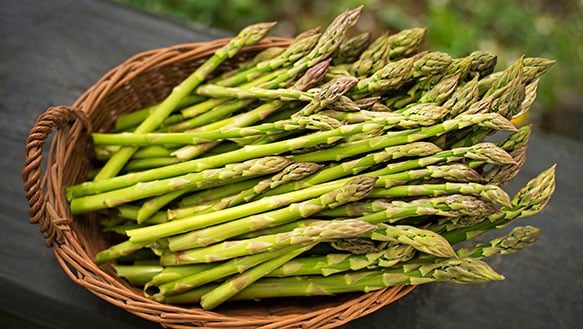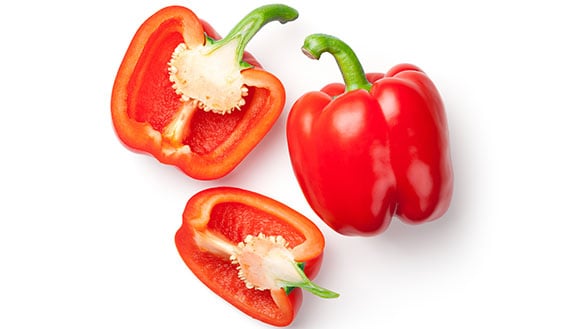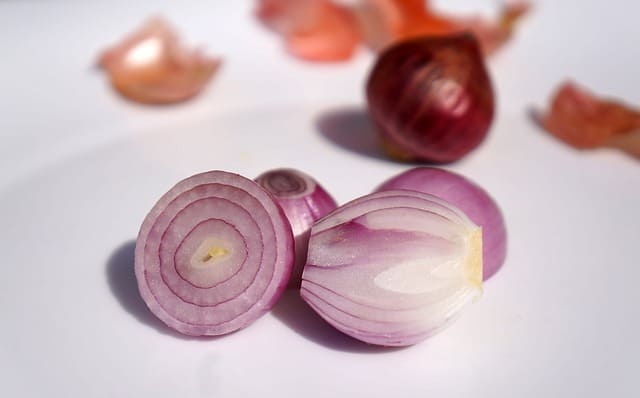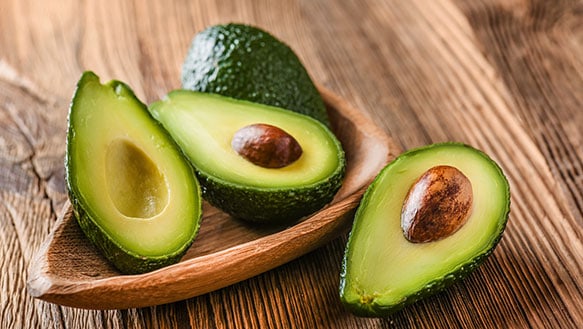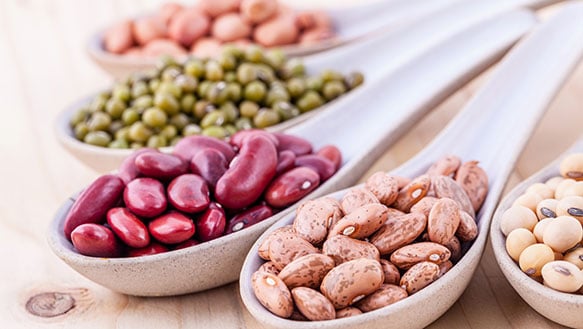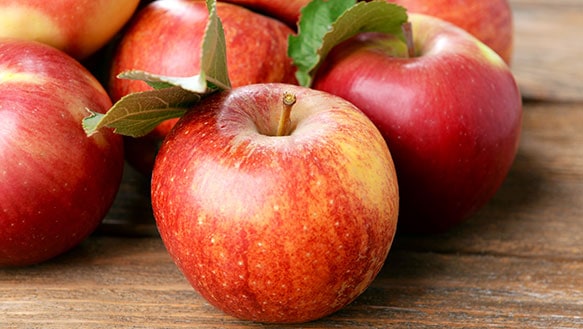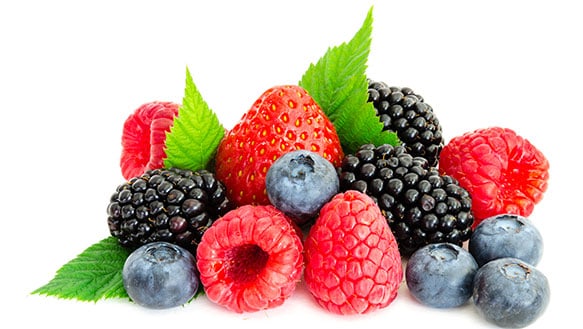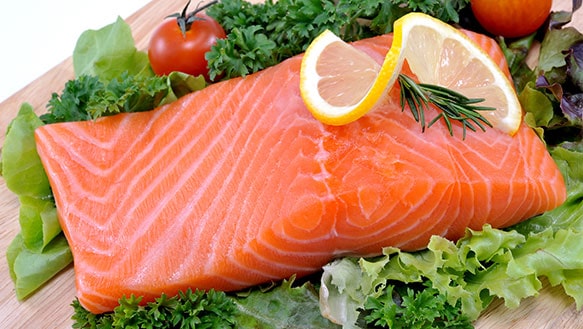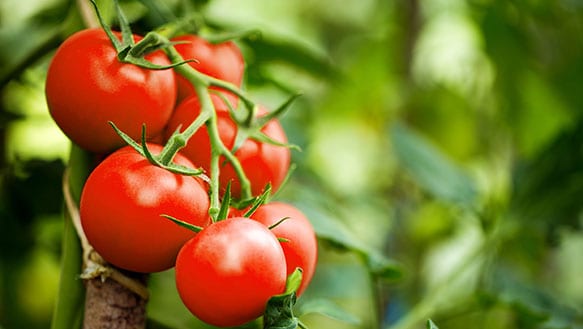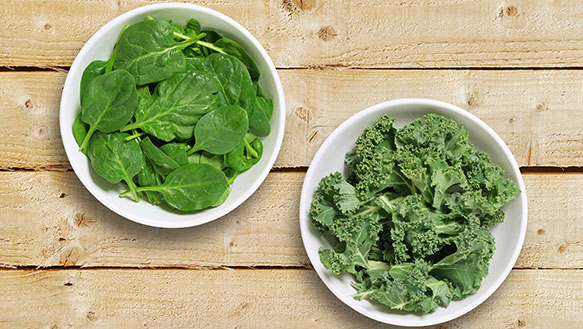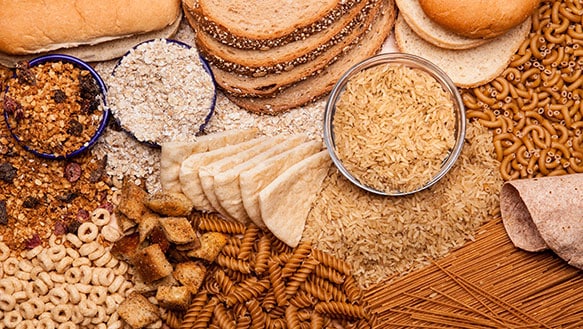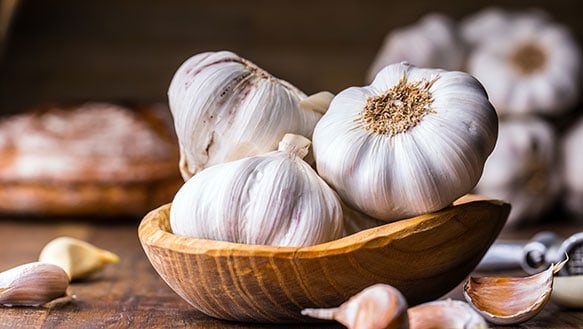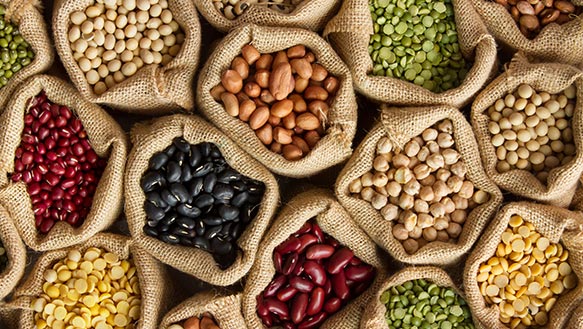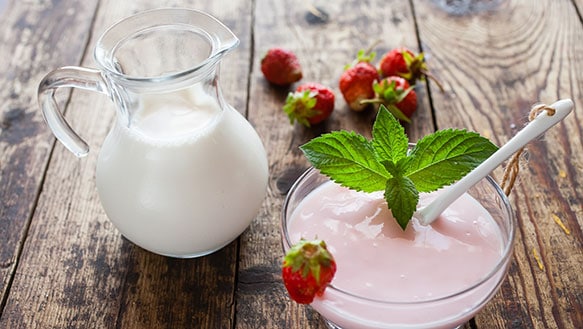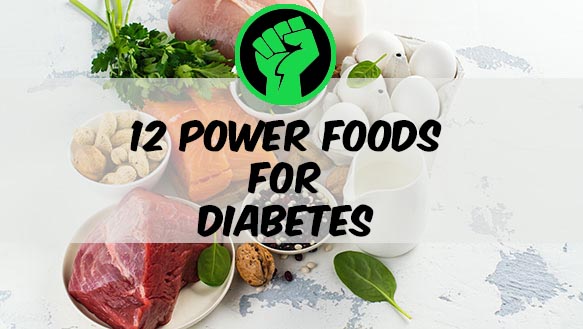
We have compiled 12 best power foods to eat with diabetes.
Let’s say you want to amp up your nutrition and swap out certain unhealthy foods that you eat for more healthy choices.
These are our top 12 picks:
Contents
1. Non-starchy vegetables
Our top choices for non-starchy vegetables are asparagus, red peppers, purple onions and broccoli. There are many other non-starchy vegetables that are healthy to add to your diet.
Non-starchy veggies tend to be very low in carbohydrates, therefore most of them are included on the American Diabetes Associations “free food list.” In other words, you don’t have to even worry about counting the carbohydrates in them.
That’s partly because they’re “good carbohydrates,” mostly fiber which cancels out the sugar on the glycemic index and they are loaded in vitamins, minerals and antioxidants, flavonoids and all sorts of other “great for you” things.
Besides our picks below, try some broccoli, red beets or any of the variety of colors of vegetables on the ADA’s free list. You’ll have your hunger satisfied with a nutritious bounty of fresh or frozen non-starchy veggies.
Avoid canned vegetables due to sodium content and loss of nutrients in the canning process. Whole, fresh vegetables are best, but frozen is ok when the vegetable is out of season.
These picks are particularly low on the GI, have fewer carbohydrates per serving, have a variety of vitamins, minerals and antioxidants to protect you from disease, and are overall good choices.
Asparagus
Asparagus is low in carbohydrates. It has “good carbohydrates” from plant sources and it’s delicious grilled, steamed, or in a variety of recipes. The carbohydrate count is just five grams. A serving provides about two grams of fiber. Asparagus is loaded with antioxidants that help protect against disease. With only 20 calories, it’s on the free vegetable list for the American Diabetes Association. The GI is low, and eating asparagus may prevent some of the effects that aging has on our bodies. One study done in the United Kingdom even suggested that asparagus can help regulate blood sugars by increasing insulin production. Yes, there’s something healthy about asparagus. It’s got lots of folate and other B vitamins, too. All these things help prevent your risk of cardiovascular disease, cancer and preserve wellness day to day by preventing illness. One serving is about a half a cup, but as said before, asparagus is a “free food.”
Red peppers
When green peppers can remain on the vine longer, they turn into red peppers. All that sitting and waiting to be picked loads them with nutrients.
They’re powerful antioxidants. They have beta carotene and Vitamin A and C. Red colored fruits and vegetables contain higher amounts of lycopene than vegetables of other colors. Spinach and carrots will also give you these benefits.
A serving is a whole cup raw, and a half a cup of cooked red peppers. Try them in all your dishes to give a rich, red color and loads of flavor.
Purple onions
Purple onions are powerful antioxidants that provide great flavor to your dishes. They’re also loaded with fiber, folate and potassium that are good for cardiovascular health.
High in flavonoids, purple onions are also preventative for cancer and other chronic illnesses. Eat a serving of a half a cup of raw purple onions in your salads, or one-half cup of cooked purple onions for your health.
2. Avocados
Wholly guacamole! Avocados are tasty and good for your cardiovascular system. They are loaded with healthy fats, which are monosaturated instead of saturated fats. That equals healthier.
What’s more, avocados can lower your cholesterol levels. It can raise the “good fats” (HDL cholesterol) in your blood stream, and lower the “bad fats,” (LDL cholesterol) in your blood stream. They can help lower your triglycerides, too.
In 2008, there was a research study in the American Journal of Clinical Nutrition related to women who consumed good fats as opposed to bad fats. The women who consumed the most good fats, as are found in avocados had a 25 percent less chance of developing T2D than those who ate foods high in saturated fats and low in good fats.
I recommend reading the following articles:
Remember your servings sizes with avocados. They do have fat, although it’s good fat – a full four grams, but they’re still fat. Therefore, a serving is one quarter of a medium sized avocado.
They pack a punch of two grams of fiber, too. Try them on your favorite sandwiches, mix them in your salads or mash them up with some lime juice and tomatoes for guacamole.
3. Beans
Beans, beans. There are literally dozens of different kinds of beans that are healthy for you to eat. They are both a protein food and they also contain a fairly high amount of carbohydrates, so they must be counted as carbohydrates.
You’ll get a lot of fiber with beans along with the vegetable protein in them. They’ve got a lot of minerals since they grow near the ground.
You’ll get plenty of potassium and magnesium from your beans, too. Beans are low GI.
Chickpeas or garbanzo beans are low on the GI index, with black beans being a bit higher. Still, they’re only about a 30 on the GI.
Try a variety for your health to reduce cardiovascular disease and help control your blood sugars. Serving size is about a half a cup:
- Navy beans
- Kidney beans
- Chickpeas
- Lentils
- Black beans
- Pinto beans
- Cannellini beans
4. Apples
Many of you have probably heard that apples are great for heart health. It’s one of the most popular sayings that describes eating apples as something healthy that can keep you healthy.
In 2012, a research study was published in the Journal of Functional Foods by scientists at Ohio State University. They studied subjects who ate one apple a day for four weeks. The subjects were able to lower their bad cholesterol by up to 40 percent.
Apples are good for diabetes and may even help protect people from T2D. They have a special antioxidant in them that is particularly effective at preventing heart disease and other chronic diseases.
For a large amount of fiber in a small package, pick up a small apple with three grams of fiber. Count it as a carbohydrate like all your fruits. It’s about 15 grams for the small apple. Many grocery store apples are much larger, so estimate if you might have two portions and eat the other half later. A little lemon juice will keep it from turning brown until you can eat the second serving.
5. Berries
Berries are loaded in antioxidants. Particularly of interest are blueberries and raspberries. Blackberries are also tasty, and strawberry’s red color provides a punch of nutritious vitamins.
In there, you’ve got your Vitamin C, loads of fiber and the highest number of antioxidants of any of nature’s bounty. For cancer, cardiovascular disease and diabetes prevention, berries are where it’s at.
They protect vision and provide anti-inflammatory properties. Raspberries have a great antioxidant power. They have anthocyanins, ellagic acid and other contents that help to lower your blood sugar and decrease insulin resistance.
If you didn’t know, raspberries come in three colors – red, black and gold. Try them all in salads, for snacks or as a healthy dessert.
6. Fatty Fish
Fish that are high in fatty acids (Omega-3) are powerful foods. Look for wild caught salmon in the seafood market or fresh fish section of your grocery store to help lower your risk for cardiovascular disease.
They’re protein, not carbohydrates, so you don’t have to count them. They won’t increase your blood sugars and may help slow the digestive process down for those foods higher in carbohydrates.
Fish oil can be taken, or you can eat herring, mackerel, tuna, mahi, or any other varieties of fish high in fatty acids. Fresh catch is best, but frozen is also acceptable, and a portion size is about 3-4 ounces. Eat fish about 2 times a week.
You’ll get your selenium and a big portion of your Vitamin D in fish. It’s great for your bones with loads of calcium, and it’s good for your nails, hair and skin as well. With healthy cholesterol (HDL) and low saturated fat content, fish is a super food for anyone.
The American Heart Association recommends fish high in Omega 3s to prevent abnormal heart rate, decrease your triglycerides, lower your blood pressure, slow the rate at which plaques stick to the inside of your arteries and keep a check on inflammation in your body.
Fish is “brain food,” and may also decrease your risk for Alzheimer’s Disease and age-related memory loss. Look for fish in season for the best prices.
7. Tomatoes
Tomatoes are loaded with lycopene. It’s a powerful antioxidant that reduces cancer risk, including cancer of the prostate. It helps prevent cardiovascular disease and prevents the debilitating vision condition known as macular degeneration.
A serving is a cup of raw or a half cup of cooked tomatoes, but they’re on the ADA’s free list, too. Therefore, you can eat as many of them as you want to.
They are low in carbohydrates and have a low GI index. They’ve been known to lower high blood pressure and protect against heart disease and T2D.
For vitamins, they’re packed full of A and C. Cooking tomatoes helps to make sure that your body can absorb the cancer-preventing lycopene in them. In the case of tomatoes, canned are good because they contain more lycopene.
When cooking your tomatoes, to preserve the lycopene in them, cook them in a little bit of olive oil. You’ll also get anti-inflammatory flavonoids and carotenoids.
Choose low sodium canned products with high lycopene content, or have your tomatoes raw for the best mix of vitamins and minerals that canning can remove.
8. Kale and Spinach
Some greens, such as iceberg lettuce, don’t have near the nutrients and healthy properties of kale or spinach. These are highly nutritious greens, and popular super foods.
Servings are free on the ADA list, and measure about one-half cup of cooked or 1 cup of raw vegetables. You’ll get a low GI food with only four grams of carbohydrates and only about 18 calories per serving.
Nutrients are packed in there with about every vitamin you can think of. Steaming, stewing, sautéing, microwaving, stir-frying or using your greens in your salad give a variety of ways to enjoy these fresh vegetables.
Kale and spinach reduce the risk of T2D by up to 14 percent. With the pigments lutein and zeaxanthin that are good for your eyes, and tend to counter-balance the effects of smoking, pollution and infections on our bodies, and protect from cataracts.
When you buy greens, look for smaller bunches for tenderness. Wash your greens and dry them. Cut the spine of the stem out of each piece so that you are not cooking and eating the tough stems, but rather the tender leaves.
It’s in there – your Vitamin A, K, glucosinolates, potassium for your blood pressure management, folate and Vitamin C. You’ll get your beta carotene for an antioxidant to protect against cancers. Enjoy greens with just 22 calories per serving and four grams of free carbohydrates.
9. Whole grains
Oats, lentils, barley and other whole grain products contain antioxidants and are high in fiber. They will help you to deal with the fat that you consume and keep your digestive system healthier.
Barley’s known to lower cholesterol and keep blood sugar levels well-managed. Lentils have plenty of B vitamins in them, as well as iron, protein and good carbohydrates. By eating your whole grains, you can better manage your diabetes.
10. Garlic
Garlic has been around for hundreds, even thousands of years. It’s used in folklore medicine and for cooling. Garlic influences on cholesterol by lowering it, thus preventing heart disease, problems with blood pressure and cancer.
Though research is contradictive as to the true benefits of garlic, it does seem to lower blood cholesterol, slow the development of plaques in the arteries (atherosclerosis), thus lowering heart attack and stroke risk.
If you have high blood pressure, research indicates that consuming garlic may lower it some. At just one gram of carbohydrates per garlic clove, if you let it rest after chopping or mashing it, it can increase the cancer fighting properties of garlic.
Use garlic in many ways. You can use it to enhance the flavor of whole grain breads, pastas, meat dishes of all kinds and sauces. It’s a very versatile super food.
11. Nuts and seeds
Flaxseeds are getting a lot of attention lately as being healthy. Along with walnuts, flaxseed contains fiber and Omega-3s. They are both a great source of magnesium.
Flax seed is loaded with all sorts of good things for us, which may be why it’s gaining so much attention on the nutrition circuit lately. Foodies everywhere are blending flaxseed into their smoothies and adding it into their recipes.
It contains alpha-linolenic acid, or ALA, which converts to Omega 3s. It gives some of the same benefits as eating fatty fish such as mackerel.
Your antioxidants are in there, too. There’s lignans, which is one that has been shown to prevent cardiovascular disease and many types of cancer. One tablespoon is a serving, and it has about three grams of fiber and three grams of carbohydrates per serving. There are 55 calories also, so like most nuts and seeds, moderation is key.
NIH has reported that flaxseed can lower A1C in those with T2D. Other studies have seen reductions in cholesterol and triglycerides when flaxseed is a part of your regular meal planning.
Another property of walnuts that’s good is that they contain ALA, also. This fatty acid is important for cardiovascular health and it also lowers cholesterol. There’s loads of vitamins and minerals in walnuts. You’ll be nourished with Vitamin E, proteins, zinc, folic acid and other minerals.
Nuts and seeds are healthy in any variety, but it seems walnut and flaxseed do have special properties that other nuts and seeds do not. Still, many other nuts and seeds are healthy for you to consume in the correct portion, which is generally one ounce (what fits in the palm of your hand).
Some nuts and seeds you may want to try are:
- Sunflower seeds
- Pecans
- Peanuts
- Macadamia nuts
- Almonds
- Brazil nuts
- Cashews
- Pumpkin seeds
- And the list goes on…
Nuts and seeds, even in small amounts, will fill you up with protein and fiber and may help you to keep your blood sugar in your target range. Nuts and seeds are low on the GI scale. Nuts and seeds have also been known to help lower a person’s risk of developing diabetes.
12. Yogurt and milk
Our final super food for people with diabetes is yogurt and milk. Milk products contain Vitamin D that’s important for your teeth, bones and overall health. Skim milk and non-fat yogurt are low on the GI scale, so they’re a good choice if you have diabetes.
Non-fat yogurt can serve as a substitute for a dessert or be used to make smoothies. Both yogurt and milk products are also an excellent source for your daily needed calcium. Your body’s vessels and muscles need calcium to function properly, as do your bones and teeth.
There’s riboflavin, or Vitamin B2, in there and protein. The best yogurt to get has active yogurt cultures to aid in digestion. It will load your gut up with healthy probiotics that help your gastrointestinal tract function properly. They’ve even been known to help with overall functioning of your immune system.
Greek yogurt has also gained in popularity and is readily available on grocery shelves. It’s lighter and fluffier than regular yogurt. You still want to look for varieties with low fat content and no added sugars. Always take a look at your food labels to get your total carbohydrate content, as it varies so much with different kinds and flavors of yogurts.
What’s a power food?
If you have diabetes, for a power food to eat we are looking for foods that are higher in fiber, antioxidants, vitamins, and minerals, all while being lower in carbohydrates and “bad” fats (saturated fats and Trans fats).
Some greens and vegetables are healthier than others, some fats are better for you than others, and some protein foods are better, etc. You get the idea. In every food group there are those foods that are healthier and therefore better for diabetes than others.
We’ve seen a move recently away from processed foods to whole foods, such as fruits, vegetables and whole grains. Some of these foods will help you manage your diabetes, some will help prevent heart disease, cancer and other diseases and illnesses.
We don’t mean that you may only eat the foods on this list, but rather you should swap them out in your diet within each food group from which they belong. You will eat other foods besides these 12 foods that are part of a healthy, low carbohydrate, low fat diet for diabetes.
To find super foods, we can also look at the Glycemic Index (GI). Look for foods that are less than 55 on the GI scale and use our list of the top 12 diabetes power foods to eat below.
We’ll count them down, but they’re in no particular order. They are all good to add in to a healthy diet with diabetes to enhance overall health and disease management. There are more power foods out there.
Further reading:
Over to you
We hope you’ve learned something from our list of power foods above. With this knowledge, we hope that you will swap out unhealthy foods in your diet for some of these great for you substitutes within each of the food groups where they’re contained. We think that you will find them to be delicious as well as nutritious, and they may even help your overall diabetes management. In fact, I believe they will if you just try some new things. These foods might be hard to eat at first but will reward your body with great nutrients.
Let us know how trying out the new power foods here worked out for you. Did you get more energy? Did you feel more full between meals? Did you notice better blood sugar management? Let us know your thoughts in the comments section below.
TheDiabetesCouncil Article | Reviewed by Dr. Christine Traxler MD on June 02, 2020.


